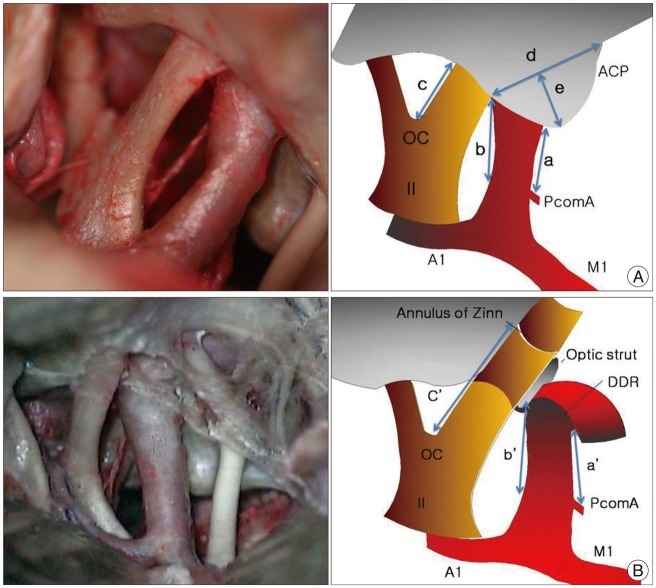1. Andaluz N, Beretta F, Bernucci C, Keller JT, Zuccarello M. Evidence for the improved exposure of the ophthalmic segment of the internal carotid artery after anterior clinoidectomy: morphometric analysis. Acta Neurochir (Wien). 2006; 148:971–975. discussion 975-976. PMID:
16917665.

2. Bouthillier A, van Loveren HR, Keller JT. Segments of the internal carotid artery: a new classification. Neurosurgery. 1996; 38:425–432. discussion 432-433. PMID:
8837792.

3. Chang DJ. The "no-drill" technique of anterior clinoidectomy: a cranial base approach to the paraclinoid and parasellar region. Neurosurgery. 2009; 64(3 Suppl):ons96–ons105. discussion ons105-106. PMID:
19240577.

4. Collignon F, Link M. Paraclinoid and cavernous sinus regions: measurement of critical structures relevant for surgical procedure. Clin Anat. 2005; 18:3–9. PMID:
15597376.

5. Coscarella E, Başkaya MK, Morcos JJ. An alternative extradural exposure to the anterior clinoid process: the superior orbital fissure as a surgical corridor. Neurosurgery. 2003; 53:162–166. discussion 166-167. PMID:
12823885.

6. De Jesús O. The clinoidal space: anatomical review and surgical implications. Acta Neurochir (Wien). 1997; 139:361–365. PMID:
9202779.

7. Dolenc VV. A combined epi- and subdural direct approach to carotid-ophthalmic artery aneurysms. J Neurosurg. 1985; 62:667–672. PMID:
3989589.

8. Erdogmus S, Govsa F. Anatomic features of the intracranial and intracanalicular portions of ophthalmic artery: for the surgical procedures. Neurosurg Rev. 2006; 29:213–218. PMID:
16775743.

9. Froelich SC, Aziz KM, Levine NB, Theodosopoulos PV, van Loveren HR, Keller JT. Refinement of the extradural anterior clinoidectomy: surgical anatomy of the orbitotemporal periosteal fold. Neurosurgery. 2007; 61(5 Suppl 2):179–185. discussion 185-186. PMID:
18091231.
10. Gibo H, Lenkey C, Rhoton AL Jr. Microsurgical anatomy of the supraclinoid portion of the internal carotid artery. J Neurosurg. 1981; 55:560–574. PMID:
7277004.

11. Huynh-Le P, Natori Y, Sasaki T. Surgical anatomy of the anterior clinoid process. J Clin Neurosci. 2004; 11:283–287. PMID:
14975418.

12. Hwang YS, Park SK, Shin HS, Kim SJ, Lee JH, Evans J. Pre -vs. post-anterior clinoidectomy measurements of the optic nerve, internal carotid artery, and optico-carotid triangle: a cadaveric morphometric study. J Korean Neurosurg Soc. 1999; 28:1082–1088.
13. Inoue T, Rhoton AL Jr, Theele D, Barry ME. Surgical approaches to the cavernous sinus: a microsurgical study. Neurosurgery. 1990; 26:903–932. PMID:
2362670.

14. Kulwin C, Tubbs RS, Cohen-Gadol AA. Anterior clinoidectomy: description of an alternative hybrid method and a review of the current techniques with an emphasis on complication avoidance. Surg Neurol Int. 2011; 2:140. PMID:
22059135.

15. Lee HY, Chung IH, Choi BY, Lee KS. Anterior clinoid process and optic strut in Koreans. Yonsei Med J. 1997; 38:151–154. PMID:
9259614.

16. Mori K, Yamamoto T, Nakao Y, Esaki T. Surgical Simulation of Extradural Anterior Clinoidectomy through the Trans-superior Orbital Fissure Approach Using a Dissectable Three-dimensional Skull Base Model with Artificial Cavernous Sinus. Skull Base. 2010; 20:229–236. PMID:
21311615.

17. Noguchi A, Balasingam V, Shiokawa Y, McMenomey SO, Delashaw JB Jr. Extradural anterior clinoidectomy. Technical note. J Neurosurg. 2005; 102:945–950. PMID:
15926728.
18. Romani R, Elsharkawy A, Laakso A, Kangasniemi M, Hernesniemi J. Complications of anterior clinoidectomy through lateral supraorbital approach. World Neurosurg. 2012; 77:698–703. PMID:
22120307.

19. Takahashi JA, Kawarazaki A, Hashimoto N. Intradural en-bloc removal of the anterior clinoid process. Acta Neurochir (Wien). 2004; 146:505–509. PMID:
15118888.

20. Yang Y, Wang H, Shao Y, Wei Z, Zhu S, Wang J. Extradural anterior clinoidectomy as an alternative approach for optic nerve decompression: anatomic study and clinical experience. Neurosurgery. 2006; 59(4 Suppl 2):ONS253–ONS262. discussion ONS262. PMID:
17041495.

21. Yonekawa Y, Ogata N, Imhof HG, Olivecrona M, Strommer K, Kwak TE, et al. Selective extradural anterior clinoidectomy for supra- and parasellar processes. Technical note. J Neurosurg. 1997; 87:636–642. PMID:
9322855.







 PDF
PDF ePub
ePub Citation
Citation Print
Print






 XML Download
XML Download